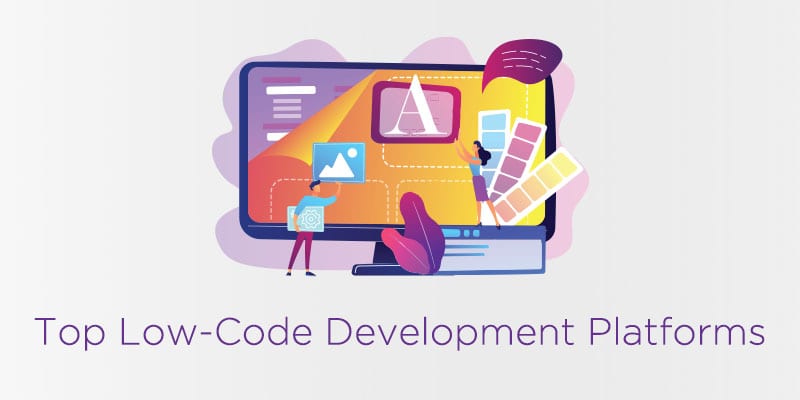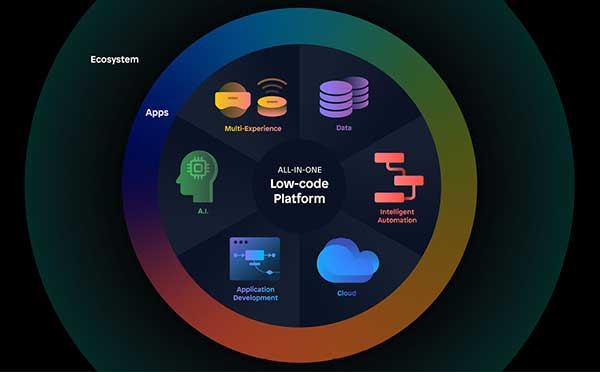Free News To Selecting application development with Low-code platforms
Wiki Article
Speed-Wise, Low-Code Applications Offer Many Advantages.
Visual Development Environment:
Drag-and-Drop Interfaces: Low-code platforms provide visual tools for designing applications. Drag-and-drop components can be used by developers to build apps quickly with no code.
Templates and pre-built components: Many low code platforms include pre-built components and templates, which allows developers to rapidly prototype and build applications.
Reduced Coding Requirements:
Automated code generation: Low-code systems generate the codes that are used to build them based on models that are visual and maintained by programmers. This eliminates the requirement to write the code manually and accelerates the process of developing.
Reusable components: Developers can to reuse components across a variety of projects, which decreases the time they're spending creating and evaluating code.
Streamlined Collaboration:
Low-code platforms include many tools that facilitate seamless collaboration between teams working on development. These include testing, version control, and deployment.
Citizen Development - Business users, non-developers and other stakeholders are able to participate in application development by using user-friendly interfaces. This helps to reduce the bottleneck caused by inaccessibility of professional developers.
Rapid Iteration and Prototyping
Rapid Prototyping Developers can swiftly create prototypes of ideas that can be evaluated and feedback collected, resulting to faster iteration.
Simple Modifications. The visual nature of low-code development allows users to modify and update their software.
Pre-built Integrations:
API Integrations. Low-code platforms usually have pre-built connectors and APIs for the most popular services that reduce the amount of time required to connect other systems.
Data integration tools: Tools to integrate data are included to help simplify the process.
Deployment, scaling and deployment:
One-Click Embedded Deployment: Many low-code platforms provide the option of deploying with one click, drastically reducing the time and effort needed to deploy apps.
Cloud-based solutions: Cloud low-code platforms are capable of handling scale and infrastructure management. Developers can then concentrate on functions and application logic instead of the deployment logistics.
The efficiency of developing low-code applications lies in its ability to simplify and automate many aspects of the app development process. This facilitates faster development of apps as well as quicker adaptation to changes in requirements. Follow the top rated the original source for Low-code Platform for application development for website recommendations including application modernisation, developing mobile apps, app platforms, database in azure, sso azure, paas service, rad application development, develop mobile application, lowcode no code, rapid application design and more.

Flexibility And Scalability Are Two Benefits Of Low Code Application Development
Low-code development can bring many benefits in terms of flexibility and scalability that are essential for building applications that are able to grow and adapt with changing business requirements. These are the major benefits: Rapid Scaling:
Cloud-Based Platforms: A large number of platforms that support low-code use cloud computing. They permit applications to grow quickly and smoothly using the cloud infrastructure. This allows businesses to manage increasing loads without worrying over managing servers.
Auto-Scaling: This feature can automatically adjust the resources based on demand. This ensures constant performance during peak times with no manual intervention.
Flexible Architecture:
Modular design Low-code platforms are a excellent way to promote modular software. This allows components to be developed independently and tested, scaled and so on. Modularity is an excellent way to increase flexibility. It can also be used to upgrade and expand components of an application without having to have the entire application affected.
Microservices Integration: Support for microservices architecture allows applications to be constructed as a collection of loosely coupled services, enhancing the scalability as well as flexibility.
Customizable Solution:
Extensibility : Low-code platforms permit developers to enhance functions beyond what they are able to provide. This lets businesses meet their own unique requirements.
Integration with Third-Party Integrations: Integration of third-party APIs and services allows companies to add more functionality to their application.
Agile Development and Deployment
Continuous Delivery and Deployment: Low-code platforms support agile methodologies that allow continuous integration and continuous delivery (CI/CD). This allows for the rapid deployment and updating of features.
Iterative Development: The nature of low-code development means applications are able to be incrementally improved and expanded, reducing risks of large-scale changes and permitting more controlled growth.
Resource Optimization
Low-code platforms provide tools to track and manage the performance of an application that help maximize the utilization of resources. This ensures that resources are being used efficiently. They are also able to be scaled up or down in accordance with the actual requirements.
Load Balancing: Integrated load balancing features distribute workloads evenly across servers, enhancing the capacity of applications to handle heavy traffic and ensure consistency in performance.
Global Reach
Multi-Region: Platform deployments that use low-code are often supported across multiple geographies, allowing businesses to provide users with low latency access to all users. This is of particular importance when it comes to applications that have an international user base.
Support for Localization Built-in support for localization lets the software be easily adapted to different languages and requirements in different markets.
Maintenance and Updates:
Simplified Maintenance: The visual and modular design of low-code software simplifies maintenance tasks, allowing bugs and updates to be made quickly, without lengthy downtime.
Version Control: Integrated version control systems handle rollbacks and changes in order to make sure that upgrades can safely be deployed and that previous versions can be restored if needed.
Cost Efficiency:
Reduced development costs: Low-code systems enable a reduction of the development cost by eliminating the need to code extensively. This allows applications to be scalable without an increasing costs or development time.
Pay-As you Go Models Numerous platforms that are low-code offer flexible pricing options, like pay-as-you-go model that aligns prices and usage with the actual growth.
In the end, low-code application development gives businesses the flexibility and capacity they require to develop robust and adaptable applications. These platforms permit rapid adjustments to the demands of changing markets as well as efficient utilization of resources and continual enhancement. Applications can evolve and adapt to the changing needs of business. See the recommended Legacy application modernization with Low-code advice for more examples including application modernization, rapid applications, rapid application design, cross platform mobile app development, cross platform mobile app development, cloud software applications, rapid app development, multiplatform mobile app development, azure sql server, app dev platform and more.

Benefits Of Low-Code Application Development In Terms Of Customization And The Limitations
The low-code approach offers an approach that is balanced and allows for substantial customization and overcomes issues. Here are a few key benefits.
Overcoming Complexity Barriers:
Simplified Development : Low-code platform reduces the complexity of development by supplying templates and components that have been pre-built, which allows rapid creation and deployment.
Guided Workflows - A lot of platforms have guided workflows or wizards that aid developers in navigating difficult processes. This decreases the possibility of errors and assures the sameness of the process.
Scalability solutions:
Built-in Scalability: Low-code platforms often include features that support scalable architecture, allowing applications to handle higher load without significant redevelopment.
Performance Monitoring: The instruments which monitor and optimize performance help to make sure that applications run efficiently, even when they grow.
Security and Compliance:
Integrated security features of Low-code come with built-in measures of security like encryption. Access control that is based on roles and automated compliance checks to address the most prevalent security concerns.
Platforms regularly update their security protocols to make sure that they comply with regulations. This helps keep the applications secure from threats that are constantly evolving.
Capabilities to Customize:
Extensibility:
Low-code platforms allow custom code They allow the integration and usage of customized code.
Moduls and plugins that are custom-designed Developers are able to develop custom plug-ins and modules that offer specific functions specifically tailored to the needs of a company.
APIs Integration
API Support: The extensive API support allows seamless integration of external systems and services. This facilitates large customization and connection.
Third Party Services: Low-code platforms usually offer pre-built connectors for popular third-party services, making it simpler to customize and integrate applications.
Flexible UI/UX:
Customizable User Interfaces: Developers can alter and create user interfaces to meet specific branding and usability requirements and provide a customized user experience.
Responsive Designs: The software can be customized to suit different screen sizes and devices.
Business Logic Customization
Visual Workflow Designers: These tools are used to customize and create workflows, as well as business logic, allowing developers to design complex processes that are tailored for their needs.
Platforms provide conditional logic that can adapt to certain business requirements or scenarios.
Data Management
Custom Data Modelling: Developers create custom models that meet particular requirements of the application. They can tailor processing of data according to a company's needs.
Advanced Data Processing: The integration with the latest tools and capabilities for data processing allows for customizing the way data is processed and utilized within the application.
Balanced Limitations and Customization
Frameworks and Standards:
Low-code platforms comply with the industry standard and best practices. This helps maintain secure and high-quality applications.
Governance Frameworks. The built-in governance frameworks make sure that any modifications do not compromise the security, compliance or integrity of the application.
Iterative Development & Feedback
Rapid prototyping: By being in a position to quickly prototype and test customizations developers can iterate on the feedback of users to enhance the app.
Continuous Improvement: Low code platforms permit constant improvement. They can be customized and enhanced when business requirements change.
User Empowerment
Enabling Citizen Developers to Develop In allowing non-developers make customizations through easy user interfaces, platforms that do not require code broaden the number of users who can customize and enhance applications.
Training and Support Many platforms provide comprehensive training and support to help users make efficient modifications without compromising the application's stability or performance.
Overall, low-code application development provides a solid system for dealing with limitations, while providing ample opportunities for customization. This balance ensures businesses can develop and maintain applications that are tailored and functional to meet their specific requirements while maintaining high standards of quality, safety and scaling.
